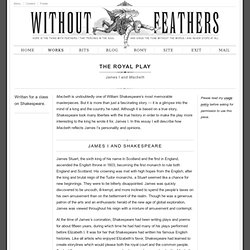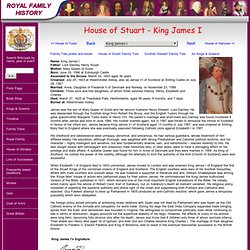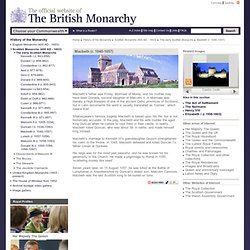

Witch hunting. Intro There was much superstition and ignorance in 17th century England.

Witchcraft had been illegal since 1563 and hundreds of women were wrongly accused and punished. 'Proof' of being a witch could be a third nipple, an unusual scar or birthmark, a boil, a growth, or even owning a cat or other pet (a 'witch's familiar', or evil spirit). Confessions were often made under torture, and suspects were tied up and thrown into a river or pond.
Floating was proof of guilt. Professionals who exposed witches could make a lot of money, as local magistrates paid the witch finder the equivalent of a month's wages. Shelfmark: E.388.(2) The Royal Play: James I and “Macbeth” Written for a class on Shakespeare.

Please read my usage policy before asking for permission to use this piece. Macbeth is undoubtedly one of William Shakespeare’s most memorable masterpieces. But it is more than just a fascinating story — it is a glimpse into the mind of a king and the country he ruled. Although it is based on a true story, Shakespeare took many liberties with the true history in order to make the play more interesting to the king he wrote it for, James I.
In this essay I will describe how Macbeth reflects James I’s personality and opinions. The Life of King James I of England. James I of England and VI of Scotland was born in 1566, the son of Mary, Queen of Scots, and Henry, Lord Darnley.

James had to face difficulties from his earliest years—his mother was an incompetent ruler who quarrelled with politicians and churchmen such as John Knox, and she may have been involved in the murder of her husband Darnley, himself a worthless character. The murder was carried out partly to avenge the slaying of Mary's secretary and possible lover, David Rizzio or Riccio, in which Darnley played a part (before James's birth), and it also enabled Mary to marry her current lover, the Earl of Bothwell. Mary was deposed by the Scottish lords in 1567, and fled to England, where she sought the protective custody of Elizabeth I, who clapped her in prison and had her beheaded twenty years later.
James published his first book in 1584, entitled The Essays of a Prentice in the Divine Art of Poesy, which he followed up in 1591 with His Majesties Poetical Exercises at Vacant Hours. 1. TimeToast Tutorial. Www.royal.gov.uk/pdf/scottish.pdf. Scottish Houses of Bruce and Stewart Family Tree. Stuart - King James I. Family Tree poster and books House of Stuart Family Tree Scottish Stewart Family Tree All Kings & Queens.

Scottish Historical Timeline. Timeline of the Kings and Queens of England. Hundreds of years ago, Britain didn't have just one king - it had lots!

Celtic kings and princes ruled Scotland, Ireland and Wales, and everything else was divided up between tribes of Anglo-Saxons. Each tribe had its own king. Sometimes one king became more powerful than the others, and for a while he would be overlord or chief king.Then in early 800s, bands of Danish Vikings from northern Europe began attacking Britain. In 878, the Saxon King of Wessex, Alfred the Great won a great battle against the Danes and forced them to agree to peace. Much of Britain was divided into Danish land (the Danelaw) and Anglo-Saxon Land (England). Gradually the Danes and the Saxons learned to live together and in 924 Athelstan (Alfred's grandson) became king of both Saxon and Danish lands - the first 'King of England'. Until 1603 the English and Scottish Crowns were separate. The Normans King William I, the Conqueror 1066 - 1087 Invaded England from Normandy.
The Domesday Book. Macbeth l The Play l Passages. The Kings of Scotland up to James VI. The early Scottish Monarchs > Macbeth. Macbeth (r. 1040-1057) Macbeth's father was Finlay, Mormaer of Moray, and his mother may have been Donada, second daughter of Malcolm II.

A Mormaer was literally a High Steward of one of the ancient Celtic provinces of Scotland, but in Latin documents the word is usually translated as 'Comes', which means Earl. Shakespeare's famous tragedy Macbeth is based upon his life, but is not historically accurate. In the play, Macbeth and his wife murder the aged King Duncan when he comes to visit them in their castle. In reality, Macbeth killed Duncan, who was about 39, in battle, and made himself king instead. Macbeth's marriage to Kenneth III's granddaughter Gruoch strengthened his claim to the throne. His reign was for the most part peaceful, and he was known for his generosity to the Church. Seven years later, on 15 August 1057, he was killed at the Battle of Lumphanan in Aberdeenshire by Duncan's eldest son, Malcolm Canmore.